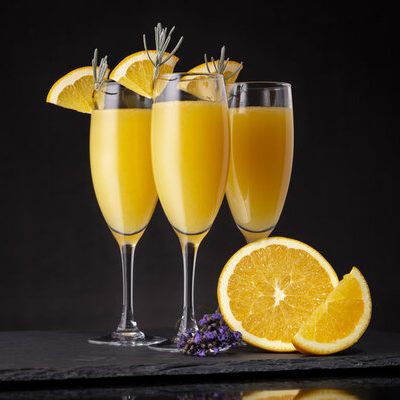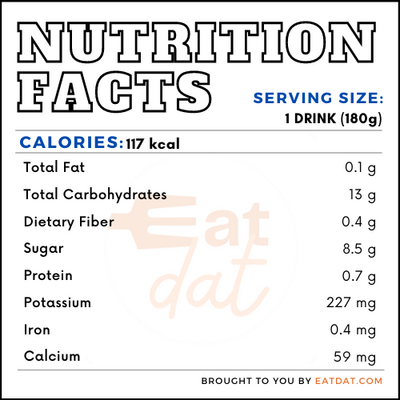
Mimosa
What is a Mimosa?
Mimosa is a cocktail prepared by blending champagne and orange juice, usually in the ratio of 2 to 1, respectively. Other sparkling wines and citrus juices may also be used in the cocktail. It is a drink that is considered elegant and is often served at weddings, business lunches, and first-class hospitality services.
- Mimosas are traditionally served in champagne flute glasses.
- The name of the cocktail comes from the bright yellow flowers of the mimosa plant, which resemble the color of the drink.
Some popular mimosa variations include:
- Buck’s Fizz
- Poinsettia
- Lemosa
- Vermosa
- Soleil
- Megmosa
Origin of mimosas
There are two stories regarding the origin of the mimosa cocktail. One version credits the invention of the drink to Frank Meier of the Ritz Hotel in Paris. The second version tells the story of a French bartender who stole the idea from a London pub, where it was served as Buck’s Fizz. This cocktail was invented in Buck’s Club in 1921. It is also possible that these are two parts of the same tale. Alfred Hitchcock is commonly credited with popularizing this cocktail.
Nutrition
One drink (180g) of mimosa contains:

Orange juice is high in vitamin C, potassium, folate, magnesium, and iron. Regular intake can help strengthen the immune system, maintain blood pressure, and keep bones strong. Also, it is a beneficial drink for pregnant women, as it promotes fetal growth. Nonetheless, fresh orange juice is more nutritious and has more vitamin C than processed orange juice. Furthermore, overconsumption of orange juice can be detrimental due to its high sugar content.
Sparkling wine has polyphenols and antioxidants. Regular consumption of champagne, in moderation, may lead to a lowered risk of cardiovascular disease. The presence of flavonoids in the wine may help in keeping neurodegenerative diseases, such as Alzheimer’s and dementia, at bay. Additionally, regular wine consumption has been found to help in bone retention and prevent osteoporosis and arthritis. However, overconsumption of alcoholic beverages in general may lead to health problems.
Commercial production
Mimosas are made with champagne and orange juice. The best sparkling wine to use in a mimosa is a dry or semi-dry variety, in order to balance the sweetness of the juice. Also, using fresh, pulp-free, chilled orange juice gives the best results. First, the orange juice is poured into the champagne flute glass, and then champagne is added. Once the champagne has settled, more may be added, depending on taste.
The most commonly used ratio of sparkling wine to orange juice is 2:1. It is advisable not to use expensive champagne for preparing this cocktail, because the delicate notes get lost in the citrus juices. Furthermore, it is important to not stir the cocktail to prevent the champagne from going flat. The drink must be served chilled. It may be garnished with orange slices, pineapple wedges, kiwi slices, rosemary sprigs, basil, mint, strawberries, pomegranate seeds, and other garnishes.
Mimosa recipes
This cocktail may be used in baking desserts, as well as in marinades. Here are a few popular recipes:
- Mimosas
- Butter Cookies
- Pancakes
- Tarts
- Bundt Cake
- Glazed Mimosa Bread
- Mimosa Ice Cream Float
- Roasted Chicken
FDA regulations
The FDA follows Treasury Bureau of Alcohol, Tobacco, and Firearms (TTB) regulations when it comes to alcohol. The TTB classifies sparkling wine as grape wine made effervescent with carbon dioxide resulting solely from the fermentation of the wine within a closed container, tank, or bottle. This sparkling wine or champagne must contain more than 0.392 grams per 100 ml carbon dioxide. The FDA defines orange juice as the unfermented juice obtained from mature oranges and must not contain seeds, peel, or excessive pulp. Orange juice must have at least 11.8 percent concentration.
References
O’Neil, Carol E et al. “100% orange juice consumption is associated with better diet quality, improved nutrient adequacy, decreased risk for obesity, and improved biomarkers of health in adults: National Health and Nutrition Examination Survey, 2003-2006.” Nutrition journal vol. 11 107. 12 Dec. 2012, doi:10.1186/1475-2891-11-107, https://www.ncbi.nlm.nih.gov/pmc/articles/PMC3545988/
Jackson, Ronald S.. “Wine, food, and health.” Wine Science (2020): 947–978. doi:10.1016/B978-0-12-816118-0.00012-X, https://www.ncbi.nlm.nih.gov/pmc/articles/PMC7173466/
Is it time to rethink how much you drink?, Harvard Health Publishing, Harvard Medical School, https://www.health.harvard.edu/heart-health/is-it-time-to-rethink-how-much-you-drink
